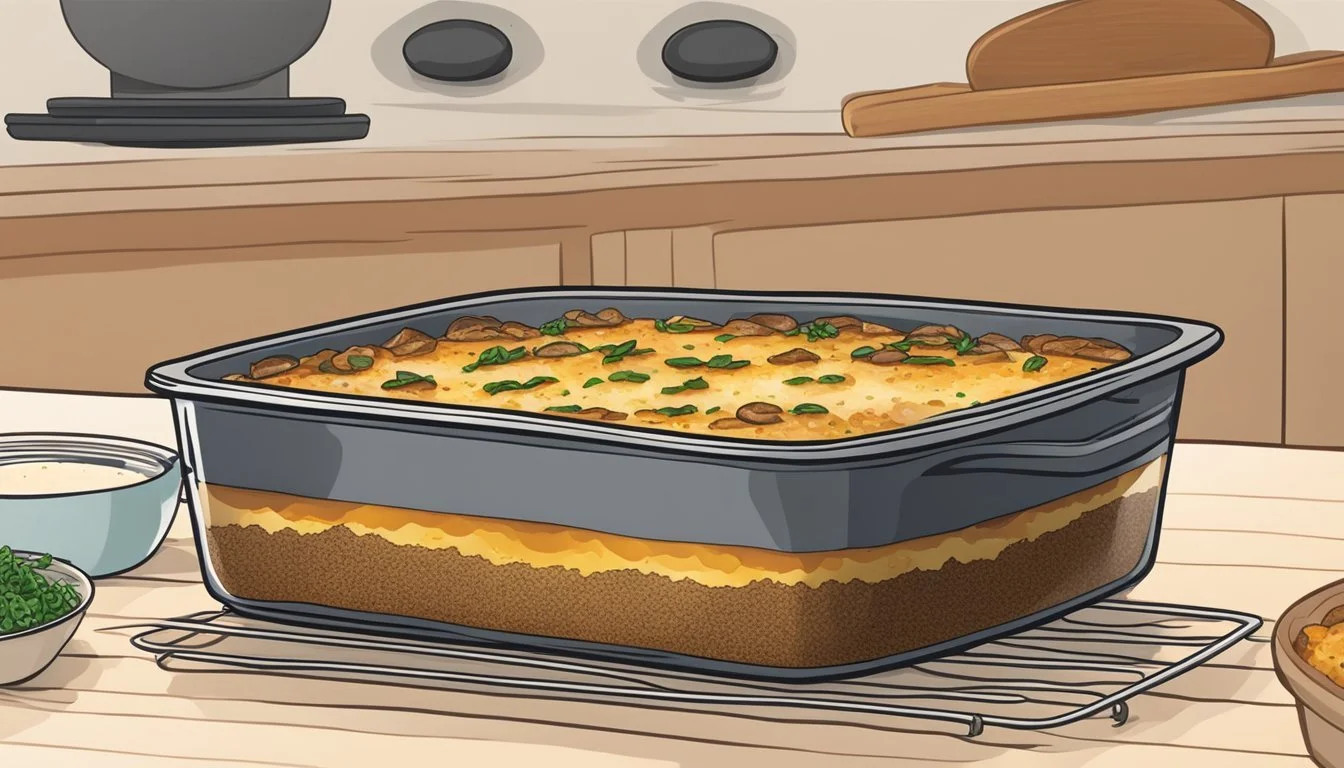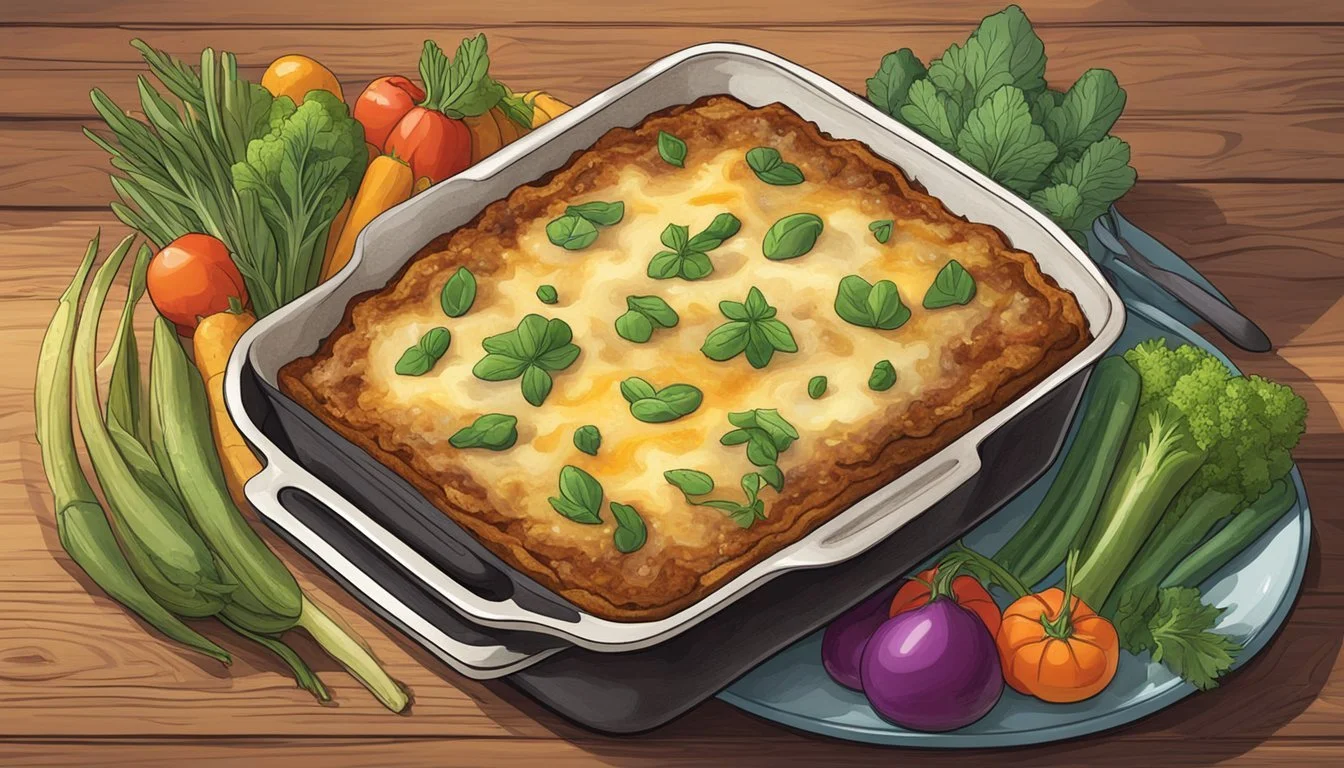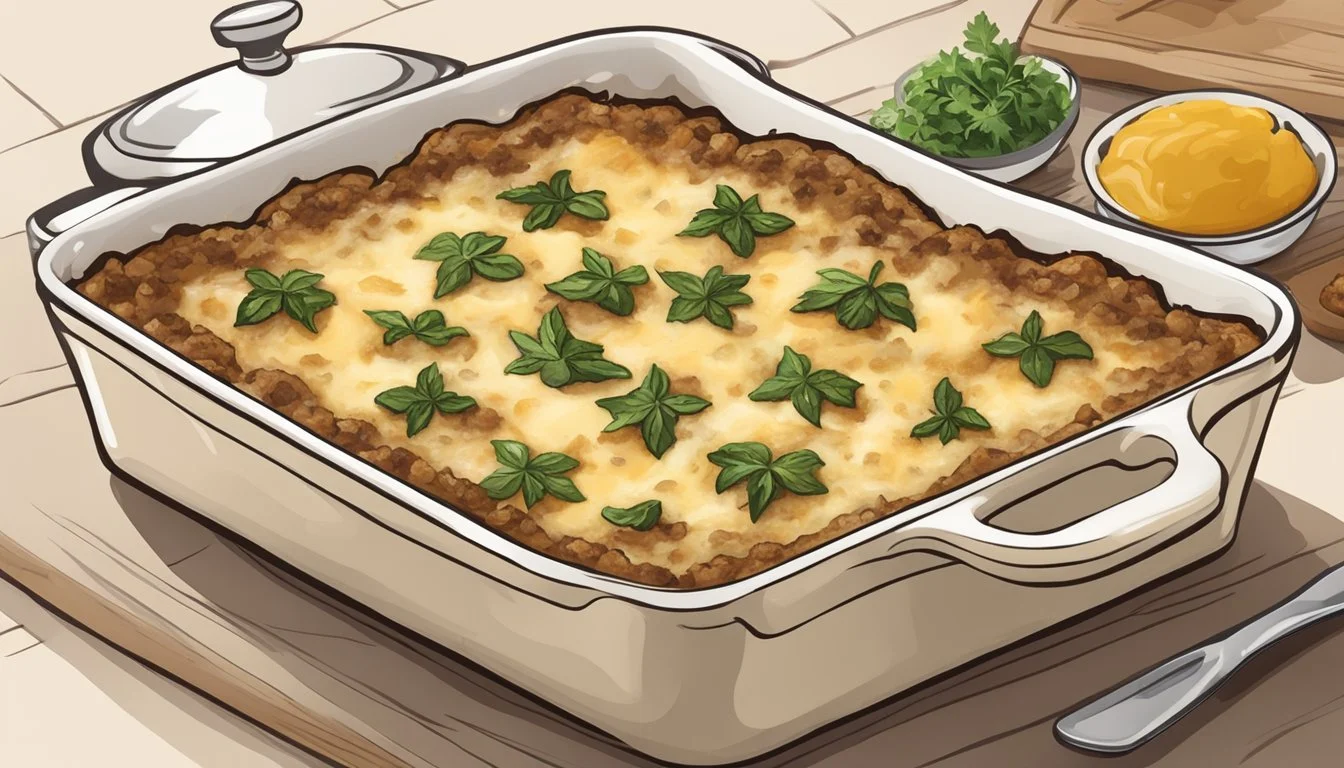How to Reheat Gluten-Free Moussaka for Perfect Taste and Texture
Reheating gluten-free moussaka can be a straightforward task with the right approach, ensuring the flavors and texture remain intact. To reheat gluten-free moussaka, preheat your oven to 350°F (177°C), cover the dish with foil, and heat for 20-30 minutes depending on the portion size. This method helps in retaining the moisture and prevents the dish from drying out.
For those with dietary restrictions, maintaining the integrity of the gluten-free components is crucial. An oven is preferred because it provides even heating, which is essential for dishes with multiple layers like moussaka. Monitoring the dish as it warms up can help ensure that it stays delicious and fresh.
Whether you have individual portions or a larger batch, adding a bit of moisture such as water or stock can be beneficial if the dish appears to be drying out. This simple trick helps in maintaining the dish's richness and flavor profile, making your gluten-free moussaka just as delightful as it was when freshly made.
Understanding Gluten-Free Moussaka
Gluten-free moussaka is distinguished by its unique combination of carefully selected components and its noteworthy health benefits. It is a delightful choice for those seeking a nutritious yet indulgent meal.
Components of Gluten-Free Moussaka
Gluten-free moussaka primarily consists of layers of eggplant, potato, and a rich meat sauce, all topped with a creamy béchamel sauce. Eggplants are sautéed to enhance their flavor, while potatoes are often pre-cooked to ensure they blend seamlessly into the dish.
The meat sauce, usually made from ground meat like lamb or beef, is flavored with a mix of herbs and spices, bringing a savory depth to the moussaka.
The béchamel sauce is crafted without gluten, using alternatives such as cornstarch or gluten-free flour. It provides the signature creamy topping, often enriched with melted cheese for added flavor. Each layer contributes to the dish's overall harmony, creating a well-balanced, flavorful profile.
Health Benefits
Gluten-free moussaka offers several health benefits. The use of eggplant and potatoes provides a good source of fiber, essential for digestive health. These vegetables are also rich in vitamins and antioxidants, which help in maintaining overall well-being.
Eggplants are low in calories but high in nutrients like potassium and vitamins B and K. Potatoes add iron and more potassium, supporting heart health and muscle function.
The addition of cheese and béchamel sauce offers a significant amount of calcium, which is essential for strong bones and teeth. Also, the dish provides a good protein content from the meat, supporting muscle repair and growth. Eating gluten-free moussaka can be a delicious way to incorporate these essential nutrients into the diet.
Essential Ingredients
To create a gluten-free moussaka that retains its traditional flavors, certain substitutes and key spices are essential. These components ensure both the texture and taste are on par with the classic dish.
Gluten-Free Substitutes
Ensuring the moussaka is gluten-free starts with replacing common ingredients that contain gluten. Gluten-free flour can substitute for regular flour in the béchamel sauce, giving it the necessary thickness without compromising on texture.
For breadcrumbs, use gluten-free breadcrumbs or crushed gluten-free crackers, which help maintain the dish's structure when layered. Gluten-free pasta might also serve as a good filler if desired, but it's less traditional.
Nutritional yeast can be an excellent addition for a cheesy flavor without gluten. Pay attention to the soy sauce or any other sauces included in the recipe, ensuring they are certified gluten-free. Opt for gluten-free tamari as a substitute.
Olive oil is typically used to sauté vegetables, and selecting a high-quality olive oil can enhance the flavor profile while keeping it gluten-free.
Key Spices and Herbs
To achieve the distinctive taste of moussaka, a blend of spices and herbs is crucial. Salt and pepper are fundamental for seasoning each layer. Garlic, either fresh or powdered, adds depth and pungency to the meat sauce.
Tinned tomatoes or fresh chopped tomatoes provide the base of the sauce, lending acidity and sweetness. Oregano and rosemary infuse the dish with a classic Mediterranean essence, while a cinnamon stick can be used in the meat sauce to deliver a subtle warmth.
Nutmeg, often grated into the béchamel sauce, gives it a rich, earthy undertone. Fresh parsley sprinkled at the end brightens up the flavors and adds a touch of color. Each of these herbs and spices plays a role in making the gluten-free moussaka taste authentic and flavorful.
Preparing Gluten-Free Moussaka
To prepare a delicious gluten-free moussaka, the key is to handle each component carefully, from the vegetables to the meat sauce and the gluten-free béchamel. Detailed instructions ensure a flawless dish every time.
Preparation of Vegetables
Start by slicing the eggplants into ¼ inch thick rounds. Lightly salt and let them sit for 30 minutes to draw out moisture.
Next, peel and slice the potatoes into thin rounds. Parboil the potatoes in salted water for about 5-7 minutes, just until they're partially cooked.
Meanwhile, pan-fry the eggplant slices in batches in olive oil until golden brown. Drain all vegetables on paper towels to remove excess oil.
Preparation of Meat Sauce
For the meat sauce, sauté a finely chopped onion in olive oil until it becomes translucent. Add ground beef and cook until browned.
Incorporate chopped tomatoes, a pinch of cinnamon, and some minced garlic. Let the mix simmer for 20-25 minutes, allowing the flavors to meld and the sauce to thicken.
Ensure the meat sauce is thoroughly cooked, seasoned with salt and pepper.
Preparation of Gluten-Free Béchamel
To prepare the gluten-free béchamel sauce, melt butter over low heat in a saucepan. Whisk in equal parts gluten-free flour until a smooth paste forms.
Slowly pour in warmed milk while whisking continuously. Once the mixture thickens, remove it from the heat.
Whisk in some grated cheese (like Parmesan) and a touch of nutmeg for flavor. Let the béchamel cool slightly before tempering a beaten egg into it. This will add richness and stability to the sauce.
Layering and Assembling
Creating a gluten-free moussaka involves careful assembly to ensure even cooking and a delightful blend of flavors. The process includes layering vegetables, meat sauce, and a rich béchamel sauce.
Order of Layers
Begin by greasing a large baking dish. The first layer typically consists of potato slices, laid evenly across the bottom. This layer serves as the base and helps to soak up flavors from the meat sauce.
Next, add a layer of roasted eggplant slices. Roasting the eggplants beforehand enhances their flavor. Spread half of the prepared meat sauce over the eggplants, ensuring an even distribution.
Repeat by adding another layer of eggplant, followed by the remaining meat sauce. This even layering ensures each bite contains a balanced flavor profile.
Final Touches Before Baking
Top the layers with a thick, smooth béchamel sauce. The béchamel should cover the entire surface, sealing in the flavors below. For a gluten-free option, use a mixture of gluten-free flour and milk to prepare the béchamel sauce.
Sprinkle a generous amount of grated cheese and breadcrumbs over the béchamel. The cheese creates a cheesy, golden crust, while breadcrumbs add a subtle crunch.
Bake the assembled moussaka at 350°F for about 45 minutes or until the top is golden brown and set. Let the casserole sit for at least 15 minutes after baking to allow it to firm up before serving.
Baking Gluten-Free Moussaka
Baking gluten-free moussaka requires careful preparation to ensure that the dish cooks evenly and achieves the desired texture and flavor.
Oven Preparation
Begin by preheating the oven to 350°F (177°C). This ensures a consistent cooking temperature. Select a suitable baking dish, ideally one that distributes heat evenly.
Grease the baking dish lightly with olive oil to prevent sticking.
Position the moussaka layers evenly within the baking dish. Typically, the dish includes a base of sliced eggplants, a layer of seasoned ground meat, and a top layer of béchamel sauce. This arrangement affects the final texture and flavor.
Cover the baking dish with aluminum foil during the initial baking phase. This helps retain moisture and cook the layers evenly.
Baking Time and Temperature
Bake the moussaka at 350°F (177°C) for about 30-40 minutes. This initial bake allows the flavors to meld together. Check if the dish is warming evenly by inserting a clean knife into the center.
After the initial bake, remove the aluminum foil. Increase the oven temperature to 375°F (190°C) if you prefer a more golden brown top layer. Bake for an additional 10-15 minutes without the foil to brown the béchamel layer.
Check the internal temperature using a meat thermometer; it should reach 165°F (74°C). This ensures that all the ingredients are cooked through without overcooking the dish. Adjust time based on your oven's performance.
Proper Reheating Techniques
Reheating gluten-free moussaka can be done effectively using either an oven or a microwave. Each method has specific steps to ensure the dish retains its flavor and texture without compromising its gluten-free nature.
Reheating in the Oven
Using the oven is ideal for reheating gluten-free moussaka as it provides even heat distribution. Preheat the oven to 350°F (177°C). Place the moussaka in a baking dish and cover it with aluminum foil to prevent drying.
For individual portions, heat for about 20 minutes. Larger portions may require 30-40 minutes. If dryness occurs, add a small amount of water or stock before covering. Periodically check to ensure the moussaka is thoroughly warmed.
Reheating in the Microwave
The microwave offers a quicker option for reheating. Place the moussaka in a microwave-safe dish, covering it loosely with a microwave-safe lid or plate to let steam escape.
Set the microwave to medium-high and heat the moussaka for approximately 2 minutes. After heating, stir gently and check if it’s warm enough. If needed, continue heating in 30-second intervals until the desired temperature is reached. This method is perfect for small portions of leftovers.
Serving and Pairing Suggestions
Reheating gluten-free moussaka can be a delightful experience, especially when paired with the right accompaniments and wines.
Accompaniments
To elevate the dining experience, consider pairing your reheated moussaka with a Greek salad. The freshness of tomatoes, cucumbers, onions, and olives, combined with feta cheese, creates a well-balanced contrast to the rich, savory moussaka. A drizzle of olive oil and a sprinkle of oregano enhance the flavors.
Tzatziki sauce, a refreshing mix of yogurt, cucumber, garlic, and dill, also works well. It adds a cool, creamy texture that complements the warm, hearty moussaka. For an additional touch, serve with warm pita bread or gluten-free flatbread.
Wine Pairing
Selecting the proper wine can further enhance your gluten-free moussaka experience. A red wine such as Xinomavro brings out the moussaka’s rich flavors with its strong tannins and acidity.
If you prefer white wine, Assyrtiko offers a sharp, crisp taste that effectively balances the dish's savory and creamy elements. For a more aromatic experience, a Moschofilero with its floral notes pairs nicely, especially if garnishing with fresh herbs like parsley or basil.
Choosing these accompaniments and wines ensures a meal as delightful as the original preparation.
Storing Gluten-Free Moussaka
Proper storage of gluten-free moussaka is essential to maintain its flavor and texture. This section will guide you on how to refrigerate or freeze your moussaka to ensure it stays fresh for as long as possible.
Refrigeration Tips
When planning to eat gluten-free moussaka within a few days, refrigerate it for best results. Let the moussaka cool completely after cooking. Transfer it into an airtight container or wrap it tightly with plastic wrap to prevent moisture loss and contamination. Label the container with the date to track its freshness.
Store it in the fridge at a temperature of 40°F (4°C) or lower. This setting ensures the dish maintains its quality. Consume refrigerated moussaka within 3-4 days for optimal taste and safety.
Freezing for Long-Term Storage
For long-term storage, freeze gluten-free moussaka. Allow the dish to cool entirely before prepping it for freezing. Wrap the cooled moussaka tightly in plastic wrap, then cover it with aluminum foil for extra protection.
Alternatively, place it in a freezer-safe bag or container. Label the package with the date to monitor storage duration. Store the moussaka in the freezer at 0°F (-18°C) or below. When stored properly, it can last up to 3 months without significant loss in quality.
To thaw, transfer the moussaka to the fridge and let it thaw overnight before reheating.
Alternative Gluten-Free Moussaka Variations
Several alternatives can enhance the traditional gluten-free moussaka, making it suitable for different dietary preferences and adding unique flavors.
Vegan and Dairy-Free Options
For those who avoid animal products, vegan and dairy-free moussaka options are available. Plant-based cheeses and vegan bechamel sauce replace traditional dairy components without sacrificing flavor. Recipes often use cashew cream or coconut milk for a creamy texture. Lentils serve as a substantial and protein-rich meat substitute. Ingredients like roasted eggplants, zucchinis, and potatoes provide essential textures and layers.
Vegan varieties often incorporate nutritional yeast to achieve a cheesy flavor in the bechamel sauce. Olive oil can be used instead of butter, providing a rich depth to the dish. This changes produce a satisfying, health-conscious meal.
Creative Twists
Creative twists on gluten-free moussaka introduce new flavors and textures. Mushrooms can replace lentils or be added for extra umami. Some recipes use sweet potatoes instead of regular potatoes for a unique sweetness. Adding squash or bell peppers introduces a fresh, slightly sweet, and slightly crunchy element.
For added protein, quinoa can be mixed into the lentil filling. Herbs such as basil, mint, and rosemary add aromatic complexity. Variations might include spicy versions that incorporate chili peppers or smoked paprika for added depth. These innovations cater to adventurous palates, creating diverse gluten-free meal options.








